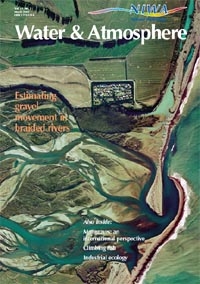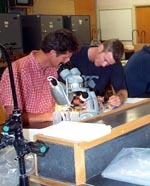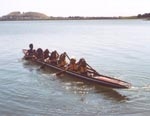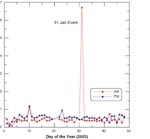
On this page
- NIWA identification workshops
- Science of waka kopapa
- Mangrove management guidelines
- Solutions to Pollution
- Australian bushfire effects
NIWA identification workshops: just ask the experts!
Have you ever had difficulty distinguishing respiratory lobes from sub-mental sclerites? Or wanted to know the difference between erect and sprawling emergent macrophytes? Or simply wanted to ask, “How diagnostic are the abdominal gill lamellae and anterior margins of the labrum in separating the leptophlebiid Ephemeroptera genera Austroclima from Mauiulus?” Have you ever just wanted to have an expert on hand?
Well, in February 2003, NIWA continued its series of Biodiversity and Ecosystem Identification Workshops, covering some of the fresh-water insects and aquatic and wetland marginal plants, and these were the sort of questions being answered by the NIWA experts.
The two-day macroinvertebrate and macrophyte workshops were held in Hamilton at the University of Waikato, and a second macroinvertebrate workshop was held at the University of Canterbury. Over 40 participants from all over the country included university staff and students, staff from regional councils (Auckland, Wellington, West Coast, Waikato, Southland, Bay of Plenty), Department of Conservation (Dunedin, Canterbury, Hamilton), Fish and Game, Waterwatch (Lincoln University), UNITEC, WINTEC, and private consultants.
Brian Smith ran the laboratory-based macroinvertebrate workshop with help from Aslan Wright-Stow. They covered seven invertebrate groups identified as “difficult” from an earlier survey of endusers: three groups of caddisflies (cased, uncased and Hydrobiosidae), Leptophlebiidae mayflies, common stoneflies, non-Chironomidae Diptera (two-winged flies), and Chironomidae (midges). Identifications were based on the aquatic larval stages of these groups.

The participants worked with laminated “quick-guides”, rich in detailed colour photographs, as identification aids for each macroinvertebrate group. These guides are formatted as flow diagrams with a series of questions about late instar specimens. Each question has “yes” and “no” options, each leading to another question until a final identification is reached.
Macroinvertebrates are identified to the level widely accepted for bio-monitoring (family or genus), and scored according to their MCI (Macroinvertebrate Community Index) value.
Labelled reference collections were available for identification practice, as well as samples from Waikato and Canterbury streams. Many participants also brought along their own material.
The workshop on emergent macrophytes proved extremely popular, with registrations far outnumbering places available. Presented by Paula Reeves and Paul Champion, the 2003 course followed on from a 2002 workshop on submerged, floating-leaved and free-floating macrophytes. Participants spent the first day of this workshop in the laboratory becoming familiar with the identification guides and plants. On the second day they took a field trip to Lakes Waahi and Whangape and to a wetland at Port Waikato. The emergent macrophyte quick-guide helped identify both native and exotic specimens.

The take-home quick guides were developed specifically for the workshops, and were based on an earlier guide to Hydrobiosidae caddisfly genera.
Following the success of these and earlier workshops, and the positive feedback from attendees, NIWA plans to run further workshops on the identification of freshwater organisms, including invertebrates, macrophytes and algae.
Brian Smith
For information about NIWA’s freshwater biodiversity identification workshop programme for 2003–04 see NIWA Training Courses or contact: Clive Howard-Williams NIWA , PO Box 8602, Christchurch ph +64 3 348 8987, fax +64 3 348 5548 [email protected]

The science of waka kopapa

On 21 February 2003, NIWA became an inaugural sponsor of an annual waka kopapa regatta for Māori children. The river waka is closest to traditional forms of canoe that are easily manoeuvrable but difficult to balance, having no seats or outriggers.
Danny and Irene Roberts of Makaurau Marae, Ihumatao, Mangere, Auckland, formed the Makaurau Marae Waka Kopapa Club over 10 months ago to teach their 32 mokopuna (grandchildren) something of their past. Their philosophy was very old – Whaia ngā taonga a o mātou tūpuna – ”Follow the treasures of our ancestors”. The regatta was designed to support the development of team, water and safety skills for Māori primary, intermediate and high school children, just as the national sport of waka ama (outrigger canoes) has for adults.
NIWA’s involvement is an extension of our developing professional relationship with the marae. Dr Michelle Kelly, of NIWA Auckland, is an auditor of the large, ongoing Watercare project to upgrade the sewage treatment system at Mangere and rehabilitate the coastline around the marae, once surrounded by 550 ha of oxidation ponds.
In May 2002 Michelle and Apanui Skipper of Te Kūwaha, NIWA’s Māori Research and Development Unit, held a hui at Makaurau Marae to determine the knowledge needs of the marae and other users of the coastal marine environment, especially with respect to traditional use, knowledge and education. At this hui kaumātua (elders) identified an urgent need for documentation of marine resources on their traditional kai moana reef, Nga Kuia e Toru, so that they could teach coastal marine biodiversity to future generations at the marae.
Michelle and others are now working with the marae to develop this tool. It is our aim to continue to support this rōpū (community group) as a contribution to the education, social and cultural development of these children.
For further information, contact Dr Michelle Kelly NIWA, Private Bag 109 695, Newmarket, Auckland ph 09 375 2050, fax 09 375 2051 [email protected]

Mangrove management guidelines
Some coastal residents around the upper North Island are concerned about the spread of mangroves, with unwelcome effects including reduced boat access, smelly mud, loss of water views, poorer fishing and shellfish gathering, and decreased property values. So what can be done about it? On one side are residents who want to reclaim their waterways by removing mangroves. On the other are residents who want to let nature be. Occupying a middle ground are residents who would be happy to contain mangroves at present levels.
To inform the debate, NIWA, NZ Landcare Trust and the Waikaraka Estuary Managers have produced For and Against Mangrove Control, in which they clarify facts about mangroves, outline consequences of proposed actions, and assess the likelihood of achieving goals.
Estuaries naturally trap and fill with sediments, and mangroves spread naturally in estuaries where climatic and other factors are favourable. However, the changes we are seeing today are the results of excessive silt inputs into estuaries caused by increased soil erosion on developing and deforested catchments. Under this deluge of silt, mangroves spread rapidly, expanding from the headwaters and sides of the estuary out into areas that were previously clean sand. The problem is an acceleration of what are otherwise natural processes.
Although they are often called weeds, mangroves do serve useful physical and ecological functions. On the physical side, mangroves stabilise sediments that might otherwise make the water cloudy and settle in other parts of the estuary. Removing mangroves could therefore cause increased turbidity and leave other habitats more prone to smothering and siltation. On the ecological side, mangroves contribute to the species and habitat diversity of estuarine ecosystems. Decomposition of fallen mangrove leaves recycles nutrients in the estuary, making them available for other photosynthetic organisms like algae. These in turn are significant sources of food for sediment-dwelling animals such as crabs, snails, cockles, and worms. Mangrove trees provide anchorage surfaces for filter-feeding organisms such as black mussels, small barnacles, rock oysters, and Pacific oysters.
Nevertheless, there are valid arguments for controlling mangroves. For example, retaining and restoring the sandy habitats that are currently being consumed by mangroves might lead to an overall increase in estuary biodiversity. We also would improve human amenity. On the other hand, mangrove control would prevent the estuary from aging naturally (see “How estuaries grow old”), although just what that means in estuaries that already have unnatural inputs of sediments is open to debate.
A successful estuary management plan will be based on the constructive involvement of all interested parties, which can be fostered by creation of a local community group. An independent facilitator may be able to help with advice and resources, and to build relationships with agencies and other parties. In Tauranga Harbour, the NZ Landcare Trust is providing such support to Waikaraka Estuary Managers and other landcare groups. Similar support is available in other areas.
The guidelines have been produced with support from FRST (C01X0215).
For an international perspective on mangroves, see “Spreading mangroves: a New Zealand phenomenon or a global trend?”.
For and Against Mangrove Control
Frequently asked questions answered ...
- If we get rid of the mangroves, will the mud then disappear?
- Are mangroves worthless?
- Do fish use mangroves in New Zealand?
- What are the ecological issues?
- Is mangrove spread related to sediment runoff from the catchment?
- Are New Zealand mangroves different from mangroves in warmer climates?
Pros and cons discussed ...
- Turn the clock back
- Draw a line in the sand
- Let nature be
You can download a PDF of For and Against Mangrove Control (NIWA Information Series No. 31, 2003) or request a copy from: Dr Malcolm Green NIWA, PO Box 11115, Hamilton ph 07 856 7026, fax 07 856 0151 [email protected].

Conference notice: “Solutions to Pollution”
The Society for Environmental Toxicology and Chemistry (SETAC) Asia/Pacific will meet in Christchurch from 28 September to 1 October 2003, in association with the Australasian Society for Ecotoxicology (ASE).
The conference theme “Solutions to Pollution” reflects a desire to address practical solutions to contaminant issues affecting the Asia/Pacific region, with an emphasis on the role of environmental chemistry and toxicological sciences in addressing environmental challenges.
To maximise such initiatives, a multi-disciplinary approach is required. The conference includes a range of sessions to promote the application of integrated science and management approaches. Special courses and workshops will be held in association with the meeting.
Abstract deadline: 2 May 2003. Conference fliers and further information are available on the ASE web site. Key contacts: Louis Tremblay, Conference Chair ([email protected]), Chris Hickey, President, SETAC Asia/Pacific ([email protected]), Jenny Stauber, President, ASE ([email protected])

Spectacular effects of Australian bushfires seen in Central Otago
Most New Zealanders heard or saw news reports about the tragic bushfires in south-west Australia in January 2003. But in some parts of the country there was visible evidence of the scale of the fires. State-of-the-art instrumentation at NIWA, Lauder, captured and explained the darkened, red skies that people saw.
Situated in rural Central Otago, NIWA’s atmospheric research facility was first set up in the 1960s to study the Aurora Australis. However, since the late 1970s it has made an important contribution to global efforts to understand the causes and effects of ozone depletion, and is one of just five global sites that comprise the international Network for the Detection of Stratospheric Change (NDSC). Recently the scope of Lauder’s research has broadened to improve our understanding of interactions between ozone depletion and other aspects of global climate change.
The January bushfires affected aerosol (airborne particles) and trace-gas levels over the whole of the south-west Pacific. This was especially visible at Lauder at the end of the month, when a strong north-westerly flow brought the plumes from these fires over southern New Zealand. The skies were noticeably dark that morning, prompting many enquiries from the public.

Satellite images showed that a patch of very high aerosol concentrations moved across the South Island on the morning of 31 January. At the same time, a digital all-sky camera, which takes images of the sky at 1-minute intervals, showed waves of reddish brown clouds passing over Lauder. The largest effects were seen about 10 am New Zealand time.
The reddish colour of the clouds was caused by nitrogen dioxide, a gas that absorbs blue light. Nitrogen dioxide (NO2) forms when the two main components of air – oxygen and nitrogen – react at high temperatures. The gas is important in both ozone depletion and climate change and has been measured continuously at Lauder for 20 years. The bushfires caused by far the largest peak seen in the data since recording began (see graph).

The peak was so dramatic because Central Otago naturally has very low levels of NO2. In cities like Christchurch, background NO2 concentrations are typically 100 to 1000 times greater, so the signal from the bushfires would have been much less obvious.
Smoke particles from bushfires can also contain a large amount of soot, including pure carbon and hydrocarbons, which can all absorb light. These substances may also have darkened both the sky and the clouds on that day, but probably did not contribute to the red colour.
For more information contact: Richard McKenzie, Ben Liley or Paul Johnston NIWA Lauder, PB 50061, Omakau, Central Otago ph 03 447 3411, fax 03 447 3348 [email protected]
